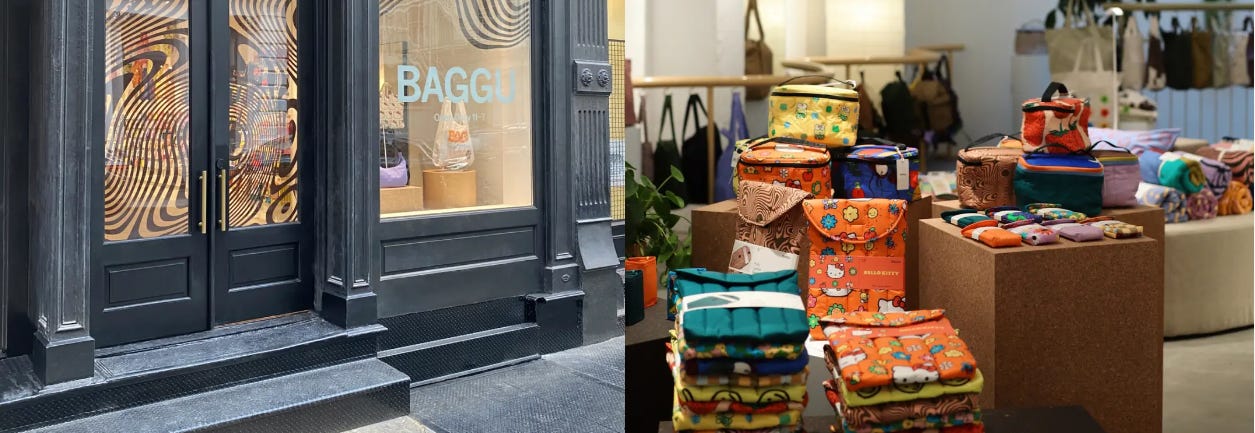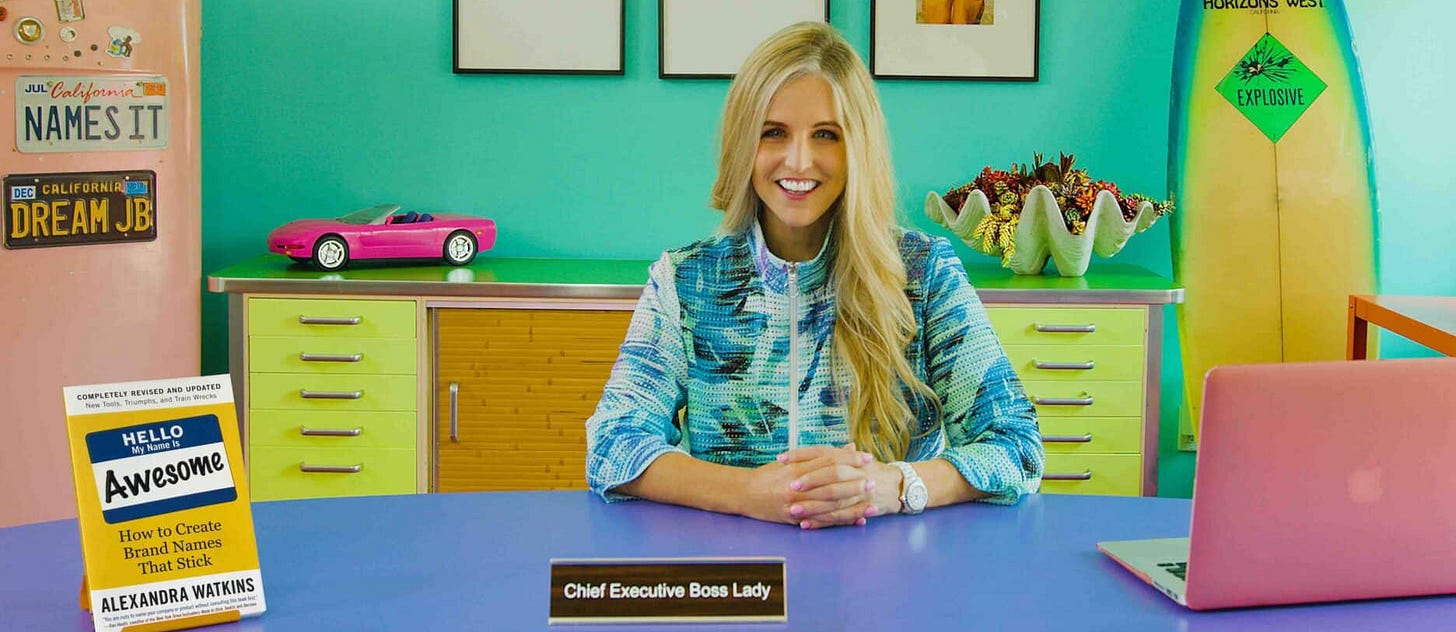Can eco-friendly brands use AI?
A minor scandal has erupted in the world of reusable shopping bags. San Francisco-based Baggu produces environmentally friendly totes with integrated folding storage pouches, typically festooned with quirky, bold prints.
Yes, we could debate whether buying too many Baggu bags defeats the environmental purpose in the same way that collectors of reusable Stanley cups have been criticized, but the company seems to make legitimate efforts to be sustainable across the board.
Last month, Baggu’s cred hit the skids when it emerged that a collab with NYC fashion label Collina Strada – which claims to be, “a platform for climate awareness, social awareness, change and self expression” – featured imagery created using artificial intelligence.
The “horse bag” in question, which costs US$70, is now seeding endless discussion on Instagram and TikTok about the implications of this design decision, with some commenters displaying a deep-rooted distaste for anything AI while others ask searching questions.
After AI image detection software revealed that the horse bag print was created using Midjourney, a slew of Baggu fans complained that creative work was being taken away from real humans. Although Collina Strada has been upfront about its use of gen AI in its designs, the lack of transparency surrounding this launch ended up hurting both brands. Once the horse bag “scandal” broke, Baggu admitted that Midjourney was used to remix old Collina prints to create a repeating pattern. Many consumers still aren’t satisfied.
Whatever your opinion of using Midjourney to help create designs, there’s an additional angle to this furore: greenhouse gas emissions.
The reason I’m covering this niche story in the Discomfort Zone intro is that the servers used to power AI queries consume enormous amounts of energy. One single ChatGPT query requires nearly ten times as much electricity as a Google search, according to Goldman Sachs in a report that outlines the increasing influence of AI data centers on power demand.
It looks like AI is here to stay, so the question we all need to ask ourselves, whether we’re buying Baggu collab tote bags or not, is whether the energy that these data centers use comes from renewable sources.
For example, in Quebec, where I live, well over 90% of our electricity comes from hydro, which has close to zero emissions. Creating dams usually has a high impact on local ecosystems, so there is an environmental cost to establishing a hydroelectric power system, but once in place, hydro has an extremely low carbon footprint. (Ontario and British Columbia are other Canadian provinces fortunate enough to rely mainly on hydroelectricity.)
If an AI server farm is set up in Quebec, it should therefore be far more green in comparison to servers located in places that mainly use oil, coal, or gas to fuel the electricity grid. As pointed out in this report from Stanford University’s Human-Centered Artificial Intelligence initiative, “researchers estimated that running a session in Estonia, which relies overwhelmingly on shale oil, will produce 30 times the volume of carbon as the same session would in Quebec, which relies primarily on hydroelectricity.”
We can all take action to protect our local and global environments, but until international systems incentivize a large-scale reduction in fossil fuel use for industry and commerce, our individual actions will have little impact. And now AI is adding a new system of fossil fuel consumption to the mix. Again, you, dear reader, should not feel bad if you prompt a chatbot any more than if you stream a movie. But the tech industry needs to think of ways to make AI data centers sustainable.
If AI is so smart, maybe they should be asking a chatbot for a solution.
Swiss firm makes awesome spray-on shoes. Runners delighted!
On designs and manufactures high-tech sports footwear and apparel in Switzerland. The company has just announced its groundbreaking LightSprayTM technology to make elite-level running shoes that reduce carbon emissions by 75% compared to their other racing shoes.
As this video shows, each shoe comes almost magically into existence by using robots to spray 1.5km of filament that is fused onto “a high-performance racing midsole, forming the complete shoe upper in a single, three-minute step. No glues, no seams.”
Would wearing these shoes make me run faster? Almost certainly not, but I love On’s commitment to technology that improves performance while cutting emissions.
Ancient wheat makes surprise comeback. World saved!
In a remarkable cross-cultural collaboration, scientists at the Chinese Academy of Agricultural Sciences have teamed up with the John Innes Centre, an independent UK research organization, and India’s Punjab Agricultural University to grow wheat from samples of now-lost varieties salvaged a century ago by British plant scientist Arthur Watkins.

After Chinese scientists sequenced the DNA from all 827 varieties of wheat collected by Watkins, the data was sent back to the UK (in a suitcase!) where traits that can make wheat more resistant to the impact of climate change and the overuse of fertilizers are being identified.
One in five calories consumed by humans comes from wheat, as has been appreciated for some time. Now, thanks to Watkins’ efforts, there are genuine hopes that the rich genetic diversity of wheat will be re-established as these rediscovered varieties are cultivated. The ultimate goal is to improve yields and feed a world facing more frequent famines due to global heating.
Tech giants make money from theft. YouTubers pissed!
Generative AI tools such as chatbots require training on large datasets. This sounds pretty geeky right? Well, let’s put this process in plainer terms: tech corporations are making billions of dollars by stealing content to program their software.
This isn’t news, but what has come to light this week is that one of the common datasets ingested to create AI products for Apple, Nvidia, and Anthropic, consists of transcripts downloaded from thousands of YouTube videos without consent from creators such as MrBeast, PewDiePie, and Marques Brownlee, as well as mainstream TV shows like The Late Show With Stephen Colbert, Last Week Tonight With John Oliver, and Jimmy Kimmel Live.
Ironically, YouTube has strict policies against copyright infringement, automatically removing content as soon as a complaint is filed, in a “guilty-until-proven-innocent” scenario. The platform is so hyper-aware of the problem that this week it released an Erase Song tool for creators to use if the soundtrack to one of their videos is taken down following a copyright complaint.
Given that YouTube parent company Alphabet also owns Google, which scraped every single book in the English language to create a searchable database, it will be interesting to see whether the YouTube dataset will trigger any legal action.
Alexandra Watkins, naming expert
I have worked on naming projects many times in my career, so I was curious to hear what an absolute genius in the field, Alexandra Watkins, would have to say about the idea that a chatbot might replace a human when a stellar brand name is needed.
Q. It's tempting for clients to think they can create a name for their company, product, or service using ChatGPT or a similar AI service. How do you convince them that these platforms are only superficially creative and that a real human being, such as yourself, is still worth the investment?
A. My role as a naming professional extends beyond simply generating names. It involves guiding the entire naming process to ensure that the final choice deeply resonates with the target audience and aligns perfectly with the brand's core identity. Here's how this process unfolds:
Strategic Insight: Understanding the brand’s vision, mission, and market nuances is crucial. A name is not just a label but a first impression, a brand promise, and a powerful communication tool. My expertise in strategic alignment ensures that the name reflects the essence of the brand and its objectives.
Emotional Connection: I craft names that weave emotional threads, turning a brand name into a story that customers want to join. This connection is achieved through an in-depth understanding of language, culture, and consumer psychology—areas where AI lacks subtlety and depth.
Creative Synthesis: My process involves synthesizing ideas, trends, and cultural insights to develop distinctive names that stand out. Unlike AI, which operates within the confines of existing data, my approach allows for true innovation and uniqueness.
Client Collaboration: Working closely with clients, I adjust to their feedback and guide them through the naming journey. This collaborative approach refines the strategy and ensures the name encapsulates the brand’s ethos, something an AI can't fully achieve.
Market Positioning: I consider how a name can differentiate a brand and capture a unique space in the consumer's mind, positioning it effectively within a competitive landscape.
Legal and Linguistic Expertise: Navigating trademark laws and linguistic checks ensures the name is not only appealing but also viable and legally defensible across different regions.
It's tempting for clients to think they can create a name for their company, product, or service using ChatGPT or a similar AI service. However, while AI can generate a high volume of names quickly, these names often lack the depth, excitement, and emotional resonance that only human creativity can provide. For instance, when I prompted ChatGPT to suggest names for a family travel game company, it offered generic options like Chuckle-filled Adventures, Jolly Journey, and Marvelous Miles. In contrast, the names I developed—such as Fun Amok, Fee-Fi-Fo-Fam, and Trippopotamus—draw from a rich tapestry of personal experiences, emotions, and insights, engaging consumers on a deeper level.
While AI tools like ChatGPT offer speed and a vast pool of ideas, they fall short in delivering names that truly inspire and stand out in a competitive landscape. For something as critical as a brand name, relying on AI is insufficient. Investing in the expertise of a naming professional, who can guide the name development process as only a human can, is not just worthwhile but essential.
Clients seeking names that truly represent their brand and capture the imagination of their audience will find that human creativity is irreplaceable in the art of naming. The best names come from the “weirdness of human brains”, a quality uniquely human and invaluable in this field. This is why, despite the rise of AI, the human touch remains crucial in crafting identities that resonate and endure.
Alexandra Watkins is a leading authority on brand names. Her breakthrough creativity book, Hello, My Name is Awesome: How to Create Brand Names That Stick, is considered “the brand name Bible” and was named a Top 10 Marketing Book by Inc. Magazine.
For nearly 20 years, Alexandra and Eat My Words have created love-at-first-sight brand names for clients from Amazon to Xerox. Her own name hall of fame includes the Wendy’s Baconator, the Neato robotic vacuum, Smitten ice cream, frozen yogurt franchise Spoon Me, Spanish language school Gringo Lingo, and the Church of Cupcakes.
The vertical farming company she named, Plenty, was recently named one of the Top 100 Most Influential Companies by Time Magazine.
HR company forgets what the “H” stands for
Lattice makes a “people management platform” that is sold to HR departments as a tool to help them run their operations. The company was founded by OpenAI CEO Sam Altman’s brother, Jack, which might explain some of what follows.
Last week, Lattice committed a huge gaffe by releasing a software upgrade that allows users to provide AI bots with employee records and include them in organizational charts. For some reason, Sarah Franklin, CEO of Lattice, was blind to the obvious issue here: the “H” in HR stands for “human”. She announced, “we want to be the first to bring an AI employee through all the same steps as a human one – onboarding, goal setting, receiving feedback – to uncover the challenges we'll face with the AI workforce, and start to come up with practical solutions for our customers.”
Online pushback was instantaneous and merciless. A senior HR program manager at Amazon commented on LinkedIn that the AI product would not meet any customer needs, adding that there are “plenty of existing human problems to solve in the HR space” which Lattice could have focused on instead.
Before the week was up, the feature was cancelled indefinitely. Amazon is not exactly known for fantastic HR practices, so when one of their HR people criticizes what you’ve done, you can be sure that your product is toast.
I guess we could classify Lattice’s face plant as an AI/HR/PR acronym clusterFK.
When your celebrity spokesperson turns out to be evil
There’s an inherent risk in hiring a spokesperson. The Hertz car rental company ran TV commercials for years featuring former NFL star OJ Simpson before he was, ironically, arrested after a slow-motion Los Angeles car chase and charged with double homicide.
The latest episode of the Freakonomics podcast is called Your Brand’s Spokesperson Just Got Arrested — Now What? and features the gut-wrenching story of what went wrong when Subway hired Jared Fogle to represent the slimming power of their products.

What Subway had no way of knowing, until he was arrested by the FBI, was that Fogle was committing child pornography crimes. But did this horrific revelation affect the Subway brand or change consumer behavior? Not really, and host Stephen Dubner explores why that was the case, alongside guest interviewees John Cawley of Cornell University, Elizabeth Zab Johnson, of the Wharton Neuroscience Initiative, and Al Roth, who’s a Nobel Prize-winning economist.
Netflix co-CEO: Don’t worry, be happy sort-of-worried!
In the New York Times podcast The Interview, Ted Sarandos, co-CEO of Netflix, said last week:
“I don’t believe that an AI program is going to write a better screenplay than a great writer, or is going to replace a great performance, or that we won’t be able to tell the difference. AI is not going to take your job. The person who uses AI well might take your job.”
What are your thoughts? You can comment directly in the Substack app or drop me a line by emailing me at john@johnbdutton.com.
And why not connect with me on LinkedIn if you haven’t already?
Legal disclaimer: All images in this newsletter that are not the property of the author or otherwise credited are reproduced under the fair use provisions of the Canadian Copyright Act while giving appropriate credit.
















